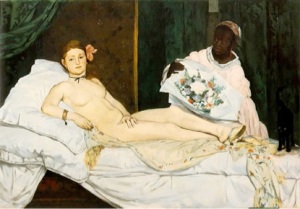Photoshop seems to be indispensable nowadays, not only to the production of beauty but also to the discussion of it. And here it is again: Anna Utopia Giordano’s Venus project photoshops classic nudes such as Titian’s Venus of Urbino below, into contemporary standards of naked beauty.
But what I can’t help wondering, with all sincerity, is why?
Some of the altered paintings look (to me) more attractive, some look weird. Yes, our standards of beauty have become more exacting and less realistic, but we know this already. Glancing through the comments on the flavorwire.com page, this seems to be the general reaction.
After all, the reworking of a traditional image is hardly new: Titian’s painting has already been reimagined in a variety of ways, Manet’s Olympia and Gauguin’s Te Arii Vahine (The King’s Wife) being only two examples.
Edouard Manet, Olympia, the Venus of Paris, 1863 (abcgallery.com)
Paul Gauguin, Te Arii Vahine (The King’s Wife), 1896 (abcgallery.com)
Manet’s Venus, with her defiant gaze at the audience and the boldly outlined, textured rendering of her body, force us to question the nature of the sexuality being represented. Gauguin’s placing of a black nude in the traditional attitude of Venus offers a reminder that we still need, of the Western presumption that beauty is a white privilege – not to mention the fallen paradise references, with the serpent coiled round the tree.
Art has been questioning beauty for centuries, and sadly I think that Giordano’s contribution simply doesn’t stand up to the richness and provocation of its predecessors. But her Photoshopped Venuses do show us something important about 21st-century beauty. Giordano’s skinny, implausibly busty nudes have lost the dynamic relationship between flesh and fantasy that characterises the originals. The Renaissance paintings show a sublimation of honest, physical bodies into a realm of dreamlike beauty; because the Photoshopped bodies are already in the dimension of fantasy, the spark of reification is lost. The picture falls flat, having no connection to the flesh we are wrapped in, but floating free in the impossible. And that’s where the project falls flat too, as Giordano leaves it there without bringing it back to earth with some seriously critical questioning.




